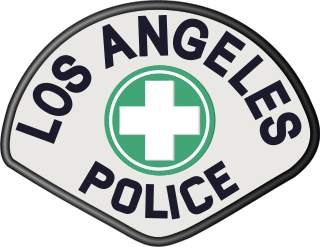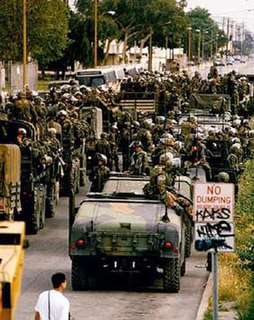Related Research Articles

The Los Angeles Police Department (LAPD), officially the City of Los Angeles Police Department, is the police department of Los Angeles, California. With 9,974 officers and 3,036 civilian staff, it is the third-largest municipal police department in the United States, after the New York City Police Department and the Chicago Police Department. The department operates in an area of 498 square miles (1,290 km2) and a population of 4,030,904 people.

A dead end, also known as a cul-de-sac, no through road or no exit road, is a street with only one inlet or outlet.
A Los Angeles Police Department C.R.A.S.H. initiative that began in April 1987, Operation Hammer was a large scale attempt to crack down on gang violence in Los Angeles, California. After a group of people at a birthday party were shot down on their front lawn in a drive-by shooting, Chief of Police Daryl F. Gates responded with a roundup of gang members. At the height of this operation in April 1988, 1,453 people were arrested by one thousand police officers in South Central Los Angeles in a single weekend.

The Community Resources Against Street Hoodlums (CRASH) was a specialized unit of the Los Angeles Police Department (LAPD) tasked with combating gang-related crime from 1979 to 2000. CRASH was established in South Central in 1979, to combat the rising problem of gangs in Los Angeles, California. Each of the LAPD's 18 divisions had a CRASH unit assigned to it, whose primary goal was to suppress the influx of gang-related crimes in Los Angeles, which came about primarily from the increase in illegal drug trade.

Daryl Gates was the Chief of the Los Angeles Police Department (LAPD) from 1978 to 1992. His length of tenure was second only to that of William H. Parker. As chief of police, he took a hardline, aggressive, paramilitary approach to law enforcement. Gates is co-credited with the creation of SWAT teams with LAPD's John Nelson, who others claim was the originator of SWAT in 1965. Gates also co-founded D.A.R.E along with the Los Angeles Unified School District.

The 1992 Los Angeles riots, sometimes called the 1992 Los Angeles uprising, were a series of riots and civil disturbances that occurred in Los Angeles County in April and May 1992. Unrest began in South Central Los Angeles on April 29, after a trial jury acquitted four officers of the Los Angeles Police Department (LAPD) for usage of excessive force in the arrest and beating of Rodney King, which had been videotaped and widely viewed in TV broadcasts.

Exposition Park in the south region of Los Angeles, California, is a 160 acres (65 ha) urban park. Established in 1872 as an agricultural fairground, it includes the Los Angeles Memorial Coliseum, the Banc of California Stadium, the California Science Center, the Natural History Museum of Los Angeles County, and the California African American Museum. The Lucas Museum of Narrative Art is under construction. Bounded by Exposition Boulevard to the north, South Figueroa Street to the east, Martin Luther King Jr. Boulevard to the south and Menlo Avenue to the west, it is directly south of the main campus of the University of Southern California.

The Yucca Corridor is a '"formerly notorious" and "once crime-ridden" stretch of Yucca Avenue in Hollywood, California, north of Hollywood Boulevard and Mann's Chinese Theater. In 2007 it was said to be "a hub for young professionals, artists, musicians and actors."

The Rampart Division of the Los Angeles Police Department (LAPD) serves communities to the west of Downtown Los Angeles (DTLA) including Silver Lake, Echo Park, Pico-Union and Westlake, all together designated as the Rampart patrol area. Its name is derived from Rampart Boulevard, one of the principal thoroughfares in its patrol area. The original station opened in 1966, located at 2710 West Temple Street. In 2008, the staff moved southeast to a newer facility located at 1401 West 6th Street. With 164,961 residents occupying a 5.4-square-mile (14 km2) area, Rampart is one of Los Angeles's most densely populated communities.
A civil gang injunction or CGI is a type of restraining order issued by courts in the United States prohibiting gang members in particular cities from participating in certain specified activities. It is based on the legal theory that gang activity constitutes a public nuisance that can prevent non–gang members of the community from enjoying peace and public order. An injunction is obtained against the gang itself, after which the police and district attorney may decide against whom they will enforce it upon. Law enforcement use gang injunctions as a tool to label people as gang members and restrict their activities in a defined area (ACLU).

The Crips are a gang based in the coastal regions of southern California. They were founded in Los Angeles, California, in 1969, mainly by Raymond Washington and Stanley Williams. Once a single alliance between two autonomous gangs, they are now a loosely connected network of individual "sets", often engaged in open warfare with one another. Their members traditionally wear blue clothing, a practice that has waned somewhat due to police crackdowns specifically targeting gang members. Historically, members have been primarily of African American heritage.
The Watts truce was a 1992 peace agreement among rival street gangs in Los Angeles, California, declared in the neighborhood of Watts. The truce was reached just days before the 1992 Los Angeles riots and, although not universally adhered to, was a major factor in the decline of street violence in the city between the 1990s and 2010s.
Operation Ceasefire (also known as the Boston Gun Project and the Boston Miracle) is a problem-oriented policing initiative implemented in 1996 in Boston, Massachusetts. The program was specifically aimed at youth gun violence as a large-scale problem. The plan is based on the work of criminologist David M. Kennedy.
The Los Angeles Police Department was formed in 1869, and has since become the third-largest law enforcement agency in the United States. They have been involved in various events in history, such as the Black Dahlia murder case, and the Rampart scandal.
Crime in Los Angeles has varied throughout time, reaching peaks between the 1970s and 1990s.

The Avenues, also known as Avenidas or AVE's, is a Mexican/Mexican American criminal street gang mostly in Los Angeles County, California. They originally started as a social club for local Latino youths to protect themselves from other violent youths. The Avenues, like most Mexican gangs in Los Angeles, are under the direct control of the Mexican Mafia when sent to State, County, or Federal prisons.
Crime in Glendale, California:

Armenian Power 13, also known as AP, the Armenian Mob, or Armenian Mafia is an Armenian criminal organization and street gang located in Los Angeles County, California. They are involved in drug trafficking, murder, assault, fraud, identity theft, illegal gambling, kidnapping, racketeering, robbery and extortion. They are believed to have over 20,000 documented members only in the U.S. but believed to have a lot more in Russia and Armenia and hundreds of associates, according to the U.S. attorney’s office. They are also well known for their affiliation with other local gangs, such as the Mexican-American mafia and certain crip gangs, most notably the notorious La Cañada OG Blocc Crips (LCBC), a violent and ruthless crip set that is extremely dedicated to expanding their territory.
White Fence is a predominantly Mexican American street gang in the Boyle Heights neighborhood of East Los Angeles.

The Bounty Hunter Watts Bloods, also known as the Bounty Hunter Bloods, is a predominantly African-American street gang situated in the Nickerson Gardens public housing projects in Watts, Los Angeles.
References
- 1 2 3 Kondo, Michelle C.; Andreyeva, Elena; South, Eugenia C.; MacDonald, John M.; Branas, Charles C. (2018). "Neighborhood Interventions to Reduce Violence". Annual Review of Public Health. 39: 253–271. doi: 10.1146/annurev-publhealth-040617-014600 . PMID 29328874.
- 1 2 3 4 "Operation Cul-de-Sac". Youth.gov. Retrieved 28 July 2020.
- 1 2 3 "Anti-gang: group denies running 'snitch network'". The Los Angeles Times. 27 June 1991.
- ↑ Lasley, J. R. (1996). Using Traffic Barriers to "Design Out" Crime: A Program Evaluation of LADP's Operation Cul-de-Sac (Report). National Institute of Justice.